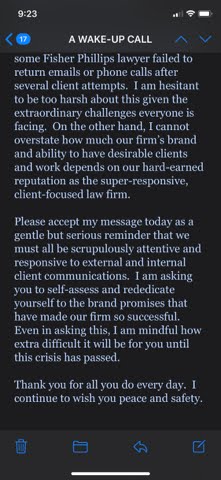Doing The Firm Not-So-Proud: Some events don’t deserve a party.
Just Returning Your Call: Lawyers may not be responding to clients during the pandemic.
Buckle In: Law firm extends work from home into 2021.
Category Added in a WPeMatico Campaign
Doing The Firm Not-So-Proud: Some events don’t deserve a party.
Just Returning Your Call: Lawyers may not be responding to clients during the pandemic.
Buckle In: Law firm extends work from home into 2021.

(Photo by Gareth Cattermole/Getty Images for Disney)
Ed. Note: Welcome to our daily feature Trivia Question of the Day!
The world recently lost a singular talent with the death of Chadwick Boseman. In addition to Jackie Robinson and King T’Challa, Boseman was known for his portrayal of legal luminary, Thurgood Marshall. What criminal case was was the focus of the 2017 biopic, Marshall?
Hint: In the case, Marshall secured an acquittal for an African-American chauffeur, played by Sterling K. Brown.
See the answer on the next page.
Lots of things in Biglaw have changed as a result of COVID-19. Offices are closing until 2021, partners and associates are sharing offices, salaries are being slashed, partners are getting forced out of firms — it’s a different world out there. But one thing that has remained constant is that it’s a demanding job.
Part of what makes Biglaw so stressful are the demands that clients make of their attorneys. And though there’s a lot that firms can/should do to improve their work environment, the needs of clients aren’t really something they can change; it’s just sort of a given.
And the management committee at Fisher Phillips wants everyone to know it.
According to sources at the firm, an email from leadership went out with an ominous subject line, A WAKE-UP CALL, last week. The timing was… not great, as a tipster notes:
[T]he management committee sent this today right at the beginning of the school year, middle of a pandemic, and right after a hurricane which directly impacts several firm offices.
It’s true there’s a lot that folks are dealing with right now, and the messaging from the firm tries to be be cognizant of that. But it also seems like several balls were dropped across the firm:
This week I have heard several reports of client relationships at risk because some Fisher Phillips lawyer failed to return emails of phone calls after several client attempts. I am hesitant to be too harsh about this given the extraordinary challenges everyone is facing. On the other hand, I cannot overstate how much our firm’s brand and ability to have desirable clients and work depends on our hard-earned reputation as the super-responsive, client-focused law firm.
The email goes on to ask all attorneys to be “scrupulously attentive and responsive external and internal client communications” and to “rededicate” themselves to the Fisher Phillips brand. It’s a hard message to hear amid a pandemic, but better to get it from firm management before clients start leaving.


 Kathryn Rubino is a Senior Editor at Above the Law, and host of The Jabot podcast. AtL tipsters are the best, so please connect with her. Feel free to email her with any tips, questions, or comments and follow her on Twitter (@Kathryn1).
Kathryn Rubino is a Senior Editor at Above the Law, and host of The Jabot podcast. AtL tipsters are the best, so please connect with her. Feel free to email her with any tips, questions, or comments and follow her on Twitter (@Kathryn1).

Hedge funds and the European Union have a bit of a thorny relationship. Actually, they more or less loathe each other, with the latter throwing around epithets like “locusts” to describe the former, and the former returning the favor by loudly cheering and bankrolling the successful effort to extricate the U.K. from the EU, and damn the consequences.
Given this rather poisonous atmosphere, any interaction between hedge funds and European regulatory authorities is likely to be unpleasant, ending with a fine or tighter regulation or misplaced blame for the money managers.
As such, it is unusual in the extreme—and generally useless folly—for hedge funds and their ilk to turn to the EU for help of any kind. On the other hand, the continentals aren’t the biggest fans of banks or their shenanigans either, and they do love to write new rules that could get financial sorts in trouble. And so with brokers apparently front-running client trades with impunity from Lisbon to Riga and the Arctic Circle to the Mediterranean coast while hiding behind a loophole-protected euphemism, hedge funds wonder if an unlikely alliance might be in the offing.
Such trades “can often constitute front-running,” the two largest lobby groups for global hedge funds, the Managed Funds Association and Alternative Investment Management Association, told regulators. “Pre-hedging essentially places the proprietary interest of the broker ahead of the de facto client….”
The Association for Financial Markets in Europe, the main lobby group for banks and brokerages, told ESMA that there is no need for new rules and that price requests don’t typically constitute inside information.
At issue in the current ESMA review is trading done primarily through request-for-quote, or RFQ, systems in which an investor typically asks several dealers for the price of an asset, such as stocks or exchange-traded funds.
Brokers anticipating an order will “pre-hedge” by buying or selling the same or similar securities or derivatives. This can happen in split seconds or minutes before the dealer actually needs to fill the position were it to win the order. The market price can move against the client, ESMA said in late 2019 when it solicited industry views on the practice.
Hedge Funds Press for Crackdown on Front-Running Loophole in EU [Bloomberg]
I am frequently the only African American woman in the room. At the end of the day, I’m a Black girl. It doesn’t matter how successful I am. It doesn’t matter how many clients I have. It doesn’t get easier and I am still a Black girl in this industry. With that barrier, I have to navigate in a different way. How? By saying (to myself), ‘Get over it.’ I don’t make excuses and I don’t let the barriers navigate where I go.
— Nicole Lynn, a litigation associate at Norton Rose Fulbright who also works as a sports agent with Lil Wayne’s Young Money agency, commenting on the diversity issues within the sports management world, which she says are even worse than those present within the legal profession. Andrew Price, a partner at the firm, says Lynn is excelling at both of her careers. “[She] has been able to do both and do them well, and I don’t know how she does it. I get emails from Nicole at all hours of the night. She has never let being an agent affect her work at the firm.”
 Staci Zaretsky is a senior editor at Above the Law, where she’s worked since 2011. She’d love to hear from you, so please feel free to email her with any tips, questions, comments, or critiques. You can follow her on Twitter or connect with her on LinkedIn.
Staci Zaretsky is a senior editor at Above the Law, where she’s worked since 2011. She’d love to hear from you, so please feel free to email her with any tips, questions, comments, or critiques. You can follow her on Twitter or connect with her on LinkedIn.
(Photo by the Defense Department via Wikimedia)
After judicial social climber Neomi Rao contorted basic conservative principles to the breaking point in an effort to deliver her patron Donald Trump the result he craved in the Michael Flynn case, the rest of the D.C. Circuit found its institutional credibility thrust into the spotlight. Rao and H.W. Bush-appointed Judge Henderson who joined the MAGA revolution had rewritten the judicial process to declare that irreparable harm exists the moment a judge asks the government to explain its motion, a conclusion that amounts to throwing the plain text of Rule 48 in the garbage bin, lighting that bin on fire, scattering its ashes, and then loudly announcing, “um, what bin?”
The rest of the D.C. Circuit offered very little patience for this. In an 8-2 ruling — with Judge Katsas sitting out as a former White House Counsel official and Justin “L’il Skippy” Walker not yet on the scene — the Circuit kicked this nonsense straight back to the curb. Echoing what everybody said about the original opinion:
Here, Petitioner and the Government have an adequate alternate means of relief with respect to both the Rule 48(a) motion and the appointment of amicus: the District Court could grant the motion, reject amicus’s arguments, and dismiss the case.’
Quite simply, the only separation-of-powers question we must answer at this juncture is whether the appointment of an amicus and the scheduling of briefing and argument is a clearly, indisputably impermissible intrusion upon Executive authority, because that is all that the District Judge has ordered at this point. We have no trouble answering that question in the negative, because precedent and experience have recognized the authority of courts to appoint an amicus to assist their decision-making in similar circumstances, including in criminal cases and even when the movant is the government.
This would be an excellent time to introduce Judge Rao to the many advantages of legal research software. Did you know that products like Westlaw and Lexis can actually show you the cases with the exact same fact pattern that are consistently decided the other way? Perhaps the rest of the D.C. Circuit should schedule a training. After all, the biggest problem in legal tech is user adoption.
Rao and Henderson dissent, rehashing the loony scribbles they backed in the original panel opinion. What’s so bizarre about the effort to transform this into a separation of powers dispute is that there was absolutely a juncture where that would have been appropriate… and the Flynn case blew by it months ago.
A prosecutor dropping a case doesn’t give a judge the authority to pursue criminal case. That’s not controversial. But neither does a prosecutor’s wishes get to dictate sentencing. Once someone is convicted, prosecutors can recommend whatever they want, but it’s in the judge’s hands at that point. Flynn went into court and swore under oath that he committed these crimes — twice — and entered a guilty plea. Under normal circumstances, this wouldn’t be the DOJ’s party anymore. If a judge decided to go over (or under) the DOJ’s sentencing recommendation, there wouldn’t be some egregious separation of powers complaint. That the prosecutors try to short-circuit this traditional distribution of powers by throwing out the charges after the charges have resulted in a conviction shouldn’t change that. That’s why trying to “square peg-round hole” that result from a jeremiad about separation of powers is so absurd. But the D.C. Circuit decides that they don’t even need to get that far yet since, of course, there’s not been any decision yet.
But let’s close by having a little pity for Judge Griffith, the W. Bush-appointee who joined the majority and used his short concurrence to try and play institutional defense for a court that appears to have a couple of MAGA rogues making up legal theories for purely partisan reasons:
In cases that attract public attention, it is common for pundits and politicians to frame their commentary in a way that reduces the judicial process to little more than a skirmish in a partisan battle. The party affiliation of the President who appoints a judge becomes an explanation for the judge’s real reason for the disposition, and the legal reasoning employed is seen as a cover for the exercise of raw political power. No doubt there will be some who will describe the court’s decision today in such terms, but they would be mistaken.
Would we? Because even Judge Griffith couldn’t keep a straight-face through his own concurrence.
[Separation of powers cases] are far removed from the partisan skirmishes of the day. The resolution of those questions in this case involves nothing more and nothing less than the application of neutral principles about which reasonable jurists on this court disagree…. And that principled disagreement revisits a long-running debate about the relative powers of the Executive and Judicial Branches.
And the next sentence…
Today we reach the unexceptional yet important conclusion that a court of appeals should stay its hand and allow the district court to finish its work rather than hear a challenge to a decision not yet made.
To recap, “separation of powers cases aren’t political… but this case isn’t really about the separation of powers regardless of what the dissenters want to pretend.” Not exactly smoothing things over.
In the end, this whole thing reads like a very cautious and thorough effort to address the fact that the D.C. Circuit has a couple of crazy aunts that they’d really rather not talk about.
(Full opinion on the next page.)
Earlier: Michael Flynn Opinion Protects Bill Barr From Having To Go Ahead And Lie Under Oath
 Joe Patrice is a senior editor at Above the Law and co-host of Thinking Like A Lawyer. Feel free to email any tips, questions, or comments. Follow him on Twitter if you’re interested in law, politics, and a healthy dose of college sports news. Joe also serves as a Managing Director at RPN Executive Search.
Joe Patrice is a senior editor at Above the Law and co-host of Thinking Like A Lawyer. Feel free to email any tips, questions, or comments. Follow him on Twitter if you’re interested in law, politics, and a healthy dose of college sports news. Joe also serves as a Managing Director at RPN Executive Search.
There’s a lot going on in the world right now. And with schools starting back up, working parents are left either organizing online learning for their kids, or sending them into in-person instruction and crossing their fingers that COVID-19 passes them by. With all that folks have to deal with, wouldn’t it be nice if they got a little something extra — money, I mean money — from their employers?
That’s what’s happening at GrayRobinson. The firm, which made $156,100,000 in 2019 gross revenue, making it 169 on the 2020 Am Law 200 ranking, sent an email to all staff members, letting them know they’re getting a bonus, payable today.
As a tipster at the firm noted, “GR just announced all staff will be receiving bonuses, crazy given these times!”

Congrats to all those getting an extra monetary thank you for their hard work. Let’s see if other Biglaw firms follow suit!
If your firm or organization is handing out bonuses, please don’t hesitate to let us know. Our vast network of tipsters is part of what makes Above the Law thrive. You can email us or text us (646-820-8477).
If you’d like to sign up for ATL’s Bonus Alerts, please scroll down and enter your email address in the box below this post. If you previously signed up for the layoff alerts, you don’t need to do anything. You’ll receive an email notification within minutes of each bonus announcement that we publish.
 Kathryn Rubino is a Senior Editor at Above the Law, and host of The Jabot podcast. AtL tipsters are the best, so please connect with her. Feel free to email her with any tips, questions, or comments and follow her on Twitter (@Kathryn1).
Kathryn Rubino is a Senior Editor at Above the Law, and host of The Jabot podcast. AtL tipsters are the best, so please connect with her. Feel free to email her with any tips, questions, or comments and follow her on Twitter (@Kathryn1).

(FREDERIC J. BROWN/AFP/Getty Images)
Do not come into U.S. District Judge Richard Leon’s courtroom and pretend that 2 + 2 = 7. The judge has had it up to here with the Trump administration waltzing in and arguing with a straight face that actually they’ve changed the plain meaning of statutes and English vernacular by executive fiat.
This morning, Judge Leon called BS on the claim that border patrol agents are functionally the same as USCIS asylum review officers. The case was brought by four mothers and their seven children whose asylum claims were rejected by the very officers charged both with interdicting them and performing a “credible fear review.”
Under 8 U.S.C.§ 1225, when an asylum seeker requests to petition for asylum citing fear of persecution or violence in her home country, immigrations officers “shall refer the alien for an interview by an asylum officer.” This would appear on its face to suggest that the immigration officer and the asylum officer are two separate people, and indeed they were for upwards of twenty years.
But on June 25, 2019, Acting CIS Director Ken Cuccinelli issued a delegation purporting to deputize CBP agents as on-the-ground asylum adjudicators, making them in effect both police officers and judges at the same time. The edict to carry out President Trump’s directive to shove as many refugees out as quickly as possible was later reaffirmed in a January 30, 2020 Memorandum of Agreement.
Under the Immigration and Nationalization Act, asylum officers must be trained in “international human rights law, nonadversarial interview techniques, and other relevant national and international refugee laws and principles” and are obliged to conduct interviews in a “nonadversarial manner.” The Department of Homeland Security argued that CBP officials whose whole job is interdicting border crossers have received comparable training, but the court wasn’t buying it.
The Government contends that CBP agents who conduct asylum interviews receive “trainings consistent with [CIS’s] prior training history and experience” and therefore meet the statutory criteria. Poppycock! The training requirements cited in the Government’s declaration do not come close to being “comparable” to the training requirements of full asylum officers. Under the January MOA, CBP agents receive “approximately 80 hours of distance training and up to 120 hours of face-to-face training.” If “comparable” means “similar or equivalent,” then 2 to 5 weeks of distance and in-person training for CBP agents is in no way “comparable” to at least 9 weeks of formal training for CIS asylum officers. See Am.Heritage Dictionary 180 (4th ed. 2001). Indeed, the Government admits that it decided that “[t]he full scope of training required for USCIS asylum officers is not necessary for [CBP agents] assigned to the limited role of conducting credible fear interviews.” (arguing “the full scope of training” is o’not required” because of the “other duties” that CIS asylum officers perform that CBP agents do not). However, regardless of the reasoning for DHS’s decision, Congress disagreed. [Internal citations omitted.]
Judge Leon was similarly skeptical of the government’s assertion that “simply ceasing an interview if an agent discovers he or she was involved in apprehending the asylum seeker being interviewed” satisfies the law’s requirement that the proceedings be “nonadversarial.”
In short, words have meaning that can’t be arbitrarily redefined by magical, executive branch incantations. And the president cannot simply issue an executive order that two weeks of training is “comparable” to nine weeks of training and evade the immigration procedures mandated by duly enacted federal statute. No one is above the law — or at least, not yet.
A.B.-8., et al. v. MARK A. MORGAN, Acting Commissioner, U.S. Customs and Border Protection, et al. [Memorandum Opinion, No. 20-cv-846-RJL (D.D.C. August 20, 2020)]
Elizabeth Dye (@5DollarFeminist) lives in Baltimore where she writes about law and politics.
Having been to more than my fair share of conferences over the years, I am convinced that a conference’s success or failure turns ultimately on one factor: the people.
I don’t mean how many people show up. I mean how they show up. Whether they bring enthusiasm for the topic, hunger for learning, openness to new ideas, willingness to share, and eagerness to network and interact.
You might say these are also the characteristics that define a community, at least a professional community.
If it is that people factor, that sense of community, that makes a conference a success, it is also what makes a virtual conference a challenge. Having now also been to my fair share of virtual conferences, that sense of community, that sense of the people, has so far been lacking. While some have had superb programming, regrettably, good programming alone does not a good conference make.
No one can deny that virtual conferences are a challenge, especially for those attending. Sitting in front of a computer screen all day listening to talking heads can be mind-numbing. The distractions of email and work are ever-present. Children clamor for attention and dogs demand to be walked. Gone are the random encounters and chance discoveries.
In short, it is hard to fully engage in a virtual conference in the way one is caught up in the swirl of away-from-home activity of a physical conference.
Such thoughts had me wondering whether we should even bother with virtual conferences. I appreciate and welcome the online training and thought leadership they offer. But why package it in the guise of a conference? Why not just stream it out in a series of programs over time and let the audience view it when they will?
A Palpable Sense of Community
But then came ILTA>ON, where the sense of community was palpable.
Last week’s ILTA>ON was the first virtual annual conference of the International Legal Technology Association. In prior years, the live ILTACON has traditionally been one of the largest, if not the largest, legal technology conferences in the world.
Last year’s conference had been the largest ever, with total attendance of some 1,850 ILTA members from all over the world, plus another 1,700 exhibitors, reporters, and others. Held at the Walt Disney World Swan and Dolphin, the conference occupied so much space that sponsors provided golf carts to transport weary attendees from venue to venue.
This year’s conference was on track to be even larger, slated for the popular Gaylord National in Opryland, just outside Nashville.
But then, of course, came the coronavirus. Organizers held out hope. In mid-April, I interviewed ILTA CEO Joy Heath Rush and asked, “Will there be an ILTACON in August?”
“ILTACON will happen, it absolutely will happen,” she replied. “Whether it happens in the way that we’re accustomed to, I think is the question.”
At that point, Rush anticipated that the conference would have both in-person and virtual components. But two months later, ILTA gave in to the unavoidable, cancelling the in-person conference and going for a fully virtual event, which it renamed ILTA>ON.
For an eleventh-hour pivot of such a massive conference, it is impressive what ILTA pulled off. Over five full days, there were, by my count, 82 distinct programs over 16 substantive tracks presented by some 200 speakers. Roughly 2,100 people registered to attend.
While most programming occurred during Chicago daytime hours, recorded and live presentations were staggered over an almost 24/7 schedule to accommodate attendees anywhere in the world. The first day’s keynote, by project management expert Stephen Carver on project failures at NASA, was broadcast live at 4 a.m. Central Time and then rebroadcast for the U.S. audience five hours later.
ILTACON is known for its over-the-top parties and social events, and while no one has yet figured out how to throw a really good party on Zoom, ILTA>ON had its own version of after-hours social events. There were comedians two nights, virtual variations on game shows Family Feud and Match Game, a virtual wine tasting, and even a tour of haunted houses.
Aiming to further facilitate online networking, ILTA>ON offered two ways for attendees to connect face-to-face away from the programs and presentations. Its Watercooler Chats were a series of scheduled informal conversations about topics that ranged from tech tips to favorite jokes. Another option, The Hallway Hang, joined attendees at random to talk about whatever they wanted.
So ILTA clearly pulled off an impressive feat of logistics on fairly short notice. But logistics do not translate to the sense of community I talked about earlier. And yet, as I said, it was palpable throughout the week.
One way this was evidenced was through the chat activity in Zoom during the keynotes and presentations. Picture a live keynote with several hundred people crowding into a ballroom as it is about to begin. As they file in, they are greeting old friends along the aisle or waving across the room to faces they recognize.
The chats were like that, especially with the morning keynotes, as attendees logged into Zoom and started sending greetings to the room and identifying where they were joining from.
The chats took on lives of their own, with people not only commenting on the talks in real time, but even sometimes going off on side conversations off-topic to the matter at hand.
Interestingly to me, the Zoom chats seemed to become a substitute for Twitter. In past years, ILTACON has been a conference with a good flow of Twitter chatter. But the Twitter chatter was noticeably sparse this year, was the Zoom chat was constantly alive with activity.
The chat activity was one tangible indicator of an intangible something-greater about this conference. That sense of community, that sense of spending time reuniting was old friends and making new ones, was pervasive. I heard it over and over again from the attendees and sponsors I spoke with: This virtual conference succeeded in feeling surprisingly like a physical conference.
Why was that? So many factors probably played a role. The programming was very good. The social events, I heard, were fun. The ad hoc networking succeeded in making new acquaintances. There was even the unique factor of live coverage all week produced by Litera.TV, for which I was fortunate enough to serve as a co-anchor with Caroline Hill, editor-in-chief of Legal IT Insider, during which we had many conversations with speakers and attendees.
But I would suggest that what gave this conference its palpable sense of community was ultimately something else altogether. It was that ILTA is an organization in which that sense of community was already strong and palpable.
Yes, ILTA’s members came to this conference full of enthusiasm, hunger for learning, openness to new ideas, willingness to share, and eagerness to network and interact.
But what they brought to this conference was something they already shared. ILTA’s strength and success as a professional organization has always been fueled by its members, many of whom are actively involved at local, national and international levels.
That sense of community at ILTA>ON was not something that sprang out of nowhere last week. It was something the attendees brought with them – and they would have brought it regardless of whether the conference was in Opryland or on the internet.
Robert Ambrogi is a Massachusetts lawyer and journalist who has been covering legal technology and the web for more than 20 years, primarily through his blog LawSites.com. Former editor-in-chief of several legal newspapers, he is a fellow of the College of Law Practice Management and an inaugural Fastcase 50 honoree. He can be reached by email at ambrogi@gmail.com, and you can follow him on Twitter (@BobAmbrogi).
is a Massachusetts lawyer and journalist who has been covering legal technology and the web for more than 20 years, primarily through his blog LawSites.com. Former editor-in-chief of several legal newspapers, he is a fellow of the College of Law Practice Management and an inaugural Fastcase 50 honoree. He can be reached by email at ambrogi@gmail.com, and you can follow him on Twitter (@BobAmbrogi).

This article has been updated with a statement from Konica Minolta.
Konica Minolta will pay $500,000 to settle a whistleblower case alleging the electronic health record systems it acquired fraudulently got certification.
In 2015, Konica Minolta acquired Viztek, a North Carolina-based health IT company. Two years later, a former Viztek employee brought a whistleblower case, which was filed under seal in the federal district court in New Jersey. It was unsealed on Thursday with the settlement agreement.
The complaint alleged that Viztek violated the False Claims Act by falsely representing that its EHR met the criteria for certification, which would allow it to receive incentive payments through the Electronic Health Record Incentive Program.
For example, the software couldn’t reliably record the data that medication history data was entered, or electronically receive and incorporate laboratory test results, according to the complaint.
Viztek allegedly hard-coded its software to pass certification requirements when it was tested in 2015. If the software failed to perform a test script, the company would request breaks, during which developers would manually adjust the software to make it appear to perform the required functions, according to the complaint.
Philips & Cohen represented the whistleblower in the case.
“Our client was concerned about possible patient harm that can occur if EHR software isn’t properly certified, so she stepped forward to inform the government about what she had witnessed,” Philips & Cohen Partner Colette Matzzie said in a news release.
The Department of Justice joined the qui tam lawsuit. Per the settlement agreement, Konica Minolta must pay the U.S. $500,000. It also cannot seek payment for any healthcare billings related to the allegations.
“The allegations emanated from a time prior to KMHA’s acquisition of Viztek,” a Konica Minolta spokesperson wrote in an emailed statement. “The company cooperated fully with the government’s investigation and maintains that the allegations are unfounded.”
The case is United States ex rel. Leighsa Wilson v. Viztek Inc. et al.
Photo credit: Mykola Velychko, Getty Images